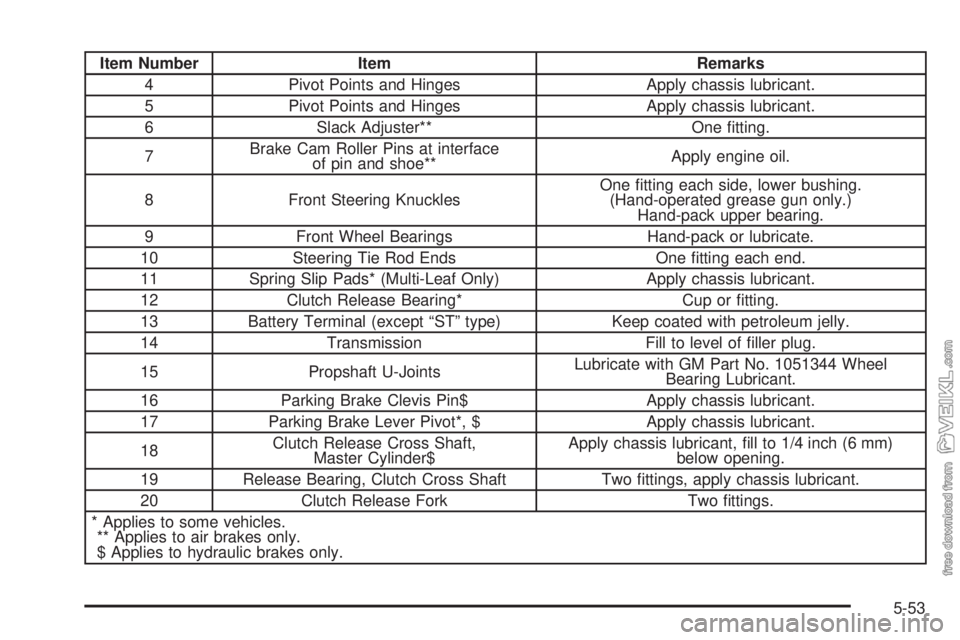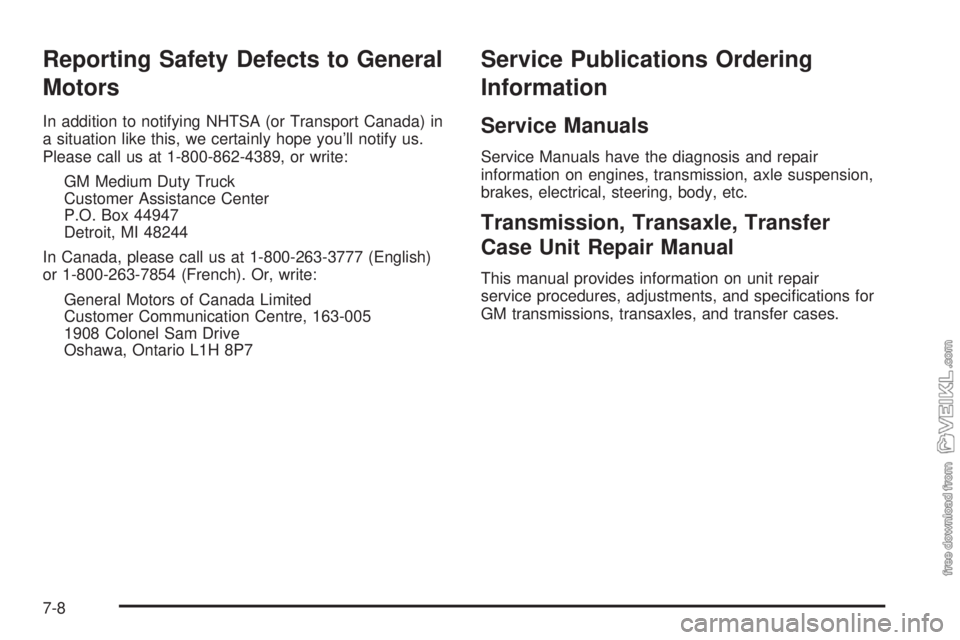2005 CHEVROLET KODIAK brakes
[x] Cancel search: brakesPage 262 of 374

Air Brake Systems
If your vehicle has air brakes, it is important to get rid of
moisture in your system. Moisture will damage your
system if it is not removed daily.
There are two ways to do this. One is automatic through
the air brake vehicle’s air dryer with intregal automatic
moisture ejector that purges air from the system through
a self-contained reservoir. The other way to drain
moisture from the air brake system is to manually
activate drain valves at each reservoir. Drain the air
reservoirs occasionally to be sure the air dryer is
working properly.
Drain the air brakes at full system pressure. To be sure
you are at full pressure, check your air pressure
gage. It should read at least 100 psi (692 kPa).
Air Dryer
If your vehicle has air brakes, it will have an air dryer.
This collects and removes dirt, moisture, or other foreign
matter from the air prior to entering the brake system.
The dryer also acts as a moisture ejector. It
automatically ejects the moisture when the compressor
cycles. The purge tank has a manual drain valve
that must be drained every day. See “Air Brake
Systems” for the manual drain procedure. The air dryer
is mounted on the passenger side frame rail.
The dryer has a filter that you need to change at
intervals. SeeScheduled Maintenance on page 6-5for
more about servicing this filter.
5-50
Page 265 of 374

Item Number Item Remarks
4 Pivot Points and Hinges Apply chassis lubricant.
5 Pivot Points and Hinges Apply chassis lubricant.
6 Slack Adjuster** One fitting.
7Brake Cam Roller Pins at interface
of pin and shoe**Apply engine oil.
8 Front Steering KnucklesOne fitting each side, lower bushing.
(Hand-operated grease gun only.)
Hand-pack upper bearing.
9 Front Wheel Bearings Hand-pack or lubricate.
10 Steering Tie Rod Ends One fitting each end.
11 Spring Slip Pads* (Multi-Leaf Only) Apply chassis lubricant.
12 Clutch Release Bearing* Cup or fitting.
13 Battery Terminal (except “ST” type) Keep coated with petroleum jelly.
14 Transmission Fill to level of filler plug.
15 Propshaft U-JointsLubricate with GM Part No. 1051344 Wheel
Bearing Lubricant.
16 Parking Brake Clevis Pin$ Apply chassis lubricant.
17 Parking Brake Lever Pivot*, $ Apply chassis lubricant.
18Clutch Release Cross Shaft,
Master Cylinder$Apply chassis lubricant, fill to 1/4 inch (6 mm)
below opening.
19 Release Bearing, Clutch Cross Shaft Two fittings, apply chassis lubricant.
20 Clutch Release Fork Two fittings.
* Applies to some vehicles.
** Applies to air brakes only.
$ Applies to hydraulic brakes only.
5-53
Page 336 of 374

(6)= Inspect brake lines and hoses for proper hook-up,
binding, leaks, cracks, chafing, etc. Inspect disc
brake pads for wear and rotors for surface condition.
Inspect caliper assemblies. Check brake pedal for
excessive free play or travel (or every 6 months,
whichever occurs first) and have serviced if needed.
Check brakes more often if driving habits and conditions
result in frequent braking.
(7)= This vehicle has the Engine Oil Life System. This
system will show you when to change the engine oil and
filter — usually between 3,000 miles (5 000 km) and
12,000 miles (20 000 km) since your last oil change.
Under severe conditions, the indicator may come on
before 3,000 miles (5 000 km). Never drive your
7.8L diesel engine vehicle more than 12,000 miles
(20 000 km), or 12 months, or 600 engine hours, without
an oil and filter change.
Remember to reset the Engine Oil Life System
whenever the oil is changed. For more information, see
Engine Oil Life System (Gasoline Engine) on page 5-29
orEngine Oil Life System (DURAMAX
®Diesel) on
page 5-31orEngine Oil Life System (Caterpillar®Diesel
Engine) on page 5-32.
(8)= This vehicle has the Engine Oil Life System. This
system will show you when to change the engine oil
and filter — usually between 3,000 miles (5 000 km) and
7,500 miles (12 000 km) since your last oil change.Under severe conditions, the indicator may come on
before 3,000 miles (5 000 km). Never drive your gasoline
engine vehicle more than 7,500 miles (12 000 km) or
12 months without an oil and filter change.
Remember to reset the Engine Oil Life System
whenever the oil is changed. For more information, see
Engine Oil Life System (Gasoline Engine) on page 5-29
orEngine Oil Life System (DURAMAX
®Diesel) on
page 5-31orEngine Oil Life System (Caterpillar®Diesel
Engine) on page 5-32.
(9)= This vehicle has the Engine Oil Life System. This
system will show you when to change the engine oil and
filter — usually between 3,000 miles (5 000 km) and
15,000 miles (24 000 km) since your last oil change.
Under severe conditions, the indicator may come on
before 3,000 miles (5 000 km). Never drive your
6.6L diesel engine vehicle more than 15,000 miles
(24 000 km), or 12 months, or 750 engine hours, without
an oil and filter change.
Remember to reset the Engine Oil Life System
whenever the oil is changed. For more information, see
Engine Oil Life System (Gasoline Engine) on page 5-29
orEngine Oil Life System (DURAMAX
®Diesel) on
page 5-31orEngine Oil Life System (Caterpillar®Diesel
Engine) on page 5-32.
6-22
Page 339 of 374

(24)= Evaporative Control System Service, if equipped:
Check all fuel and vapor lines and hoses for proper
connections and correct routing (or every 24 months,
whichever occurs first). Replace parts as needed.
(25)= Replace spark plugs. Inspect wires for damage.
Check the wire boot and boot heat shield fit at spark
plugs and coil. Replace parts as needed.
(26)= Check the fuel tank, fuel cap and fuel lines for
damage which could cause leakage. Inspect fuel cap for
correct sealing ability and any indications of damage.
Check fuel cap gasket for even filler neck imprint.
Replace parts as needed.
(27)= Check Exhaust Gas Recirculation (EGR) system
as described in the service manual. SeeService
Publications Ordering Information on page 7-8.
(28)= Inspect Electronic Vacuum Regulator Valve
(EVRV) filter for excessive contamination or plugging. If
needed, clean filter with solution of soap and water,
let dry and install.
(29)= Drain, flush, and refill cooling system. This
service can be complex; you should have your dealer
perform this service. SeePart C: Recommended Fluids
and Lubricants on page 6-32for what to use. Inspect
hoses. Clean radiator, condenser, pressure cap, andneck. Pressure test cooling system and pressure cap. For
Caterpillar®diesel engines, always refer to the
Caterpillar®Diesel Engine Operation & Maintenance
Manual for coolant recommendations and change
intervals.
(30)= Change the lubricant. SeePart C: Recommended
Fluids and Lubricants on page 6-32.
(31)= Front axle service: Re-pack upper kingpin
roller bearing.
(32)= Air brake service:
•Inspect brake lines and hoses for proper hook-up,
binding, leaks, cracks, chafing, etc. Inspect drum
brake linings for wear or cracks. Inspect other brake
parts at each wheel, including drums and wheel
speed sensor wiring. Check brake pedal for
excessive free play or travel (or every 6 months,
whichever occurs first) and have serviced if needed.
Check brakes more often if driving habits and
conditions result in frequent braking. Replace air
dryer cartridge only if excessive oil or moisture
is present. A small amount of oil in the system is
normal and should not be considered as a reason to
replace the cartridge.
6-25
Page 343 of 374

Starter Switch Check
{CAUTION:
When you are doing this inspection, the
vehicle could move suddenly. If the vehicle
moves, you or others could be injured.
1. Before you start, be sure you have enough room
around the vehicle.
2. Firmly apply both the parking brake and the
regular brakes.
Do not use the accelerator pedal, and be ready to
turn off the engine immediately if it starts.
3. On automatic transmission vehicles, try to start the
engine in each gear. The starter should work only
in PARK (P), if equipped, or NEUTRAL (N). If
the starter works in any other position, your vehicle
needs service. On manual transmission vehicles,
the starter should work only when the clutch pedal is
all the way down.
Automatic Transmission Shift
Indicator Check
Check that the indicator points to the gear chosen.
Steering Check
Be alert for any changes in steering action, abnormal
front tire wear or steering wheel position. An inspection
or service is needed when the steering wheel is
harder to turn or has too much free play, or if there are
strange sounds when turning or parking.
Brake System Check
Be alert to illumination of the low air warning lamp or for
the tone alarm, or changes in braking action, such as
repeated pulling to one side, unusual sounds when
braking or increased brake pedal travel. Make sure air
brake system reservoirs are drained daily with full
system air pressure, and check system for leaks. Any of
these conditions could indicate the need for brake
system inspection and/or service.
6-29
Page 358 of 374

Reporting Safety Defects to General
Motors
In addition to notifying NHTSA (or Transport Canada) in
a situation like this, we certainly hope you’ll notify us.
Please call us at 1-800-862-4389, or write:
GM Medium Duty Truck
Customer Assistance Center
P.O. Box 44947
Detroit, MI 48244
In Canada, please call us at 1-800-263-3777 (English)
or 1-800-263-7854 (French). Or, write:
General Motors of Canada Limited
Customer Communication Centre, 163-005
1908 Colonel Sam Drive
Oshawa, Ontario L1H 8P7
Service Publications Ordering
Information
Service Manuals
Service Manuals have the diagnosis and repair
information on engines, transmission, axle suspension,
brakes, electrical, steering, body, etc.
Transmission, Transaxle, Transfer
Case Unit Repair Manual
This manual provides information on unit repair
service procedures, adjustments, and specifications for
GM transmissions, transaxles, and transfer cases.
7-8
Page 361 of 374

A
Accessory Power Outlets.................................3-19
Adding a Snow Plow or Similar Equipment.........4-34
Adding Equipment to Your Airbag-Equipped
Vehicle.......................................................1-59
Additives, Fuel................................................. 5-6
Add-On Electrical Equipment............................5-88
Air Brake.......................................................2-40
Air Cleaner/Filter, Engine.................................5-33
Air Conditioning..............................................3-20
Air Conditioning System...................................5-70
Air Pressure Gage..........................................3-44
Air Shift Control..............................................2-27
Air Suspension...............................................2-42
Air Suspension Seats........................................ 1-6
Airbag
Off Light.....................................................3-28
Readiness Light..........................................3-27
Airbag Sensing and Diagnostic Module (SDM)...... 7-6
Airbag System................................................1-48
Adding Equipment to Your Airbag-Equipped
Vehicle...................................................1-59
Airbag Off Switch........................................1-56
How Does an Airbag Restrain?......................1-54
Servicing Your Airbag-Equipped Vehicle..........1-59
What Makes an Airbag Inflate?......................1-54
What Will You See After an Airbag Inflates?....1-54Airbag System (cont.)
When Should an Airbag Inflate?....................1-53
Where Are the Airbags?...............................1-52
AM-FM Radio.................................................3-45
Antenna, Fixed Mast.......................................3-59
Anti-Lock Brake System (ABS)........................... 4-6
Anti-Lock Brake, System Warning Light..............3-34
Anti-Lock Brakes, Trailer System
Warning Light.............................................3-34
Appearance Care............................................5-79
Aluminum or Chrome-Plated Wheels..............5-84
Care of Safety Belts....................................5-82
Chemical Paint Spotting...............................5-85
Cleaning Exterior Lamps/Lenses....................5-83
Cleaning the Inside of Your Vehicle................5-80
Fabric/Carpet..............................................5-81
Finish Care.................................................5-83
Finish Damage............................................5-85
Instrument Panel, Vinyl, and Other Plastic
Surfaces.................................................5-82
Sheet Metal Damage...................................5-85
Tires..........................................................5-85
Underbody Maintenance...............................5-85
Vehicle Care/Appearance Materials................5-86
Washing Your Vehicle...................................5-83
Weatherstrips..............................................5-82
Windshield and Wiper Blades........................5-84
Ashtrays........................................................3-20
1
Page 362 of 374

Audio System(s).............................................3-44
AM-FM Radio.............................................3-45
Care of Your Cassette Tape Player................3-58
Care of Your CD Player...............................3-59
Care of Your CDs........................................3-59
Chime Level Adjustment...............................3-59
Fixed Mast Antenna.....................................3-59
Radio with Cassette.....................................3-48
Radio with CD............................................3-53
Setting the Time..........................................3-45
Theft-Deterrent Feature................................3-57
Understanding Radio Reception.....................3-57
Automatic Ether Injection System......................5-68
Automatic Transmission
Fluid..........................................................5-34
Operation...................................................2-28
Axle, Two-Speed Rear Axle Electric
Shift Control...............................................2-26B
Battery..........................................................5-55
Bench Seat, Split............................................. 1-6
Brake
Anti-Lock Brake System (ABS)........................ 4-6
Diesel Engine Exhaust.................................2-25
Emergencies................................................ 4-8
Exhaust Indicator Light.................................3-40
Hydraulic Systems......................................... 4-6
System Warning Light..................................3-31
Trailer Hand Control Valve.............................. 4-8
Brakes..........................................................5-47
Air .............................................................2-40
Hydraulic....................................................2-38
Propshaft Brake Burnish Procedure................2-39
Braking........................................................... 4-5
Braking in Emergencies..................................... 4-8
Break-In, New Vehicle.....................................2-11
Bulb Replacement...........................................5-65
2